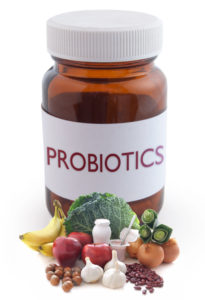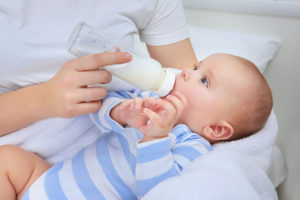Probiotics and prebiotics in infant formula: regulatory status and innovation
Posted 4 December, 2018
Breastfeeding: a natural source of probiotics and prebiotics
Probiotics have no “legal” definition, but can be considered as “living microorganisms, which when administered in adequate amo unts confer health benefits on the host” following the description provided by FAO/WHO (2006). Prebiotics, in turn, are usually deemed as “non-digestible food ingredients that beneficially affect the host by selectively stimulating the growth and/or activity of one or a limited number of bacterial species already established in the colon, and thus in effect improve host health” in accordance with the definition provided by Gibson and Roberfroid (1994). Even though they are generally added to food intentionally, probiotics and prebiotics are naturally occurring substances (with a few exceptions). One of the most widely studied natural sources of probiotics and prebiotics is human milk because of its high content in bacteria and numerous oligosaccharides. Significant advances in this area over the past years have helped to greatly narrow the distance between human milk and formula milk. However, seeing the exact properties of human milk reproduced in milk formulas – the holy grail of the industry – will take more research and development and a more pragmatic approach from regulators.
unts confer health benefits on the host” following the description provided by FAO/WHO (2006). Prebiotics, in turn, are usually deemed as “non-digestible food ingredients that beneficially affect the host by selectively stimulating the growth and/or activity of one or a limited number of bacterial species already established in the colon, and thus in effect improve host health” in accordance with the definition provided by Gibson and Roberfroid (1994). Even though they are generally added to food intentionally, probiotics and prebiotics are naturally occurring substances (with a few exceptions). One of the most widely studied natural sources of probiotics and prebiotics is human milk because of its high content in bacteria and numerous oligosaccharides. Significant advances in this area over the past years have helped to greatly narrow the distance between human milk and formula milk. However, seeing the exact properties of human milk reproduced in milk formulas – the holy grail of the industry – will take more research and development and a more pragmatic approach from regulators.
The role of prebiotics and probiotics in human milk
Breastfeeding is still the preferred nutrition option amongst paediatricians and health professionals worldwide because it provides the adequate nutrients for infants. However, the main reason behind it does not only lie on its optimal nutritional composition, but also on other substances and compounds providing active and passive immunity to infants.
Human milk is a powerful immunomodulator containing a large number of different enzymes, hormones and other substances which enhance and aid the development of infant immunity systems in early life (Hemarajata and Versalovic, 2013). It is also a rich source of probiotic bacteria: hundreds of species have been isolated so far (Li S.W. et al., 2017), with Lactobacillusand Bifidobacteriumgenus being especially relevant to human milk immune properties. The beneficial effects of these bacteria on the immune system are well-known by the scientific community. These naturally present bacteria will colonise the gut during the first stages of life and play an important role in aiding the development and preservation of the integrity of the intestinal mucosal barrier. The scientific consensus is that probiotics mainly exert their function by competing with pathogens for nutrients and binding sites on the intestinal epithelium, hence altering the composition of the microbial community. However, different studies propose additional mechanisms linked to their immunomodulation effect: production of antimicrobial substances, bacterial growth inhibitors, enhancement of the intestinal barrier and modulation of human intestinal cells gene expression (Daliri and Lee, Byong, 2015). In addition, it is important to note that a correct balance of the microbial community (and their microbiome) is tightly linked to future disease susceptibility and prevention (constipation, allergies, etc.).

Although the presence of bacteria in high numbers in the milk is partly responsible for the changes in the intestinal microbial communities, it is not the only factor modulating the intestinal bacteria balance. Nutritional compounds in human milk, mainly (but not exclusively) oligosaccharides, will also play a part in maintaining a good balance as this fraction will be selectively metabolised by beneficial bacteria. The fermentation of those carbohydrates will further promote the settling and growth of the bacteria and will result in the production of immunomodulating substances such as short chain fatty acids (Gibson and Roberfroid, 1994).
Probiotics and prebiotics in infant and follow-on formulas: regulatory status
However, regular milk, which is used in the manufacturing of infant formula (IF) and follow-on formulas (FOF), cannot shape infant immune systems as human milk does. For that purpose, probiotics and prebiotics have been added to IF and FOF for a long time to supply the lack of naturally present immunomodulators. Research and innovation in those products aim to mimic human milk’s natural content in nutrients, prebiotics and probiotics to provide non-breastfed infants the same health benefits. Special remarks should be made on the development and introduction of synthetic human milk oligosaccharides in the market, which have played an invaluable role in the refinement of IF and FOF. Surprisingly, despite the wide use of live microorganisms in infant formulas over the past decades, the use of probiotics is still not regulated by specific laws in the EU. Its use in IF and FOF is only supported by Article 5 to Directive 2006/141/EC, which states that other ingredients (in addition to the ones disclosed in the same law) may be added to IF if their safety and suitability for infants can be proven based on scientific evidence. In addition, Regulation (EC) No. 1333/2008 specifies that non-pathogenic L(+)-lactic acid producing cultures are allowed to be usedin the manufacturing of acidified milks. Nevertheless, the addition of prebiotics, in the form of fructo-oligosaccharides and galacto-oligosaccharides, is explicitly permitted under the same Directive. It is to be noted that Directive 2006/141/EC supposed a big step for the industry as it enabled health claims to be used in IF and FOF, while the old Directive 91/321/EC only allowed nutritional claims. The list of authorised nutrition and health claims in IF and FOF is disclosed in Annex IV to Directive 2006/141/EC. Nevertheless, no health claim in IF and FOF has been authorised so far, and only protein hydrolysates can bear a claim describing its role in reducing the risk of developing allergy to milk proteins.
If we carefully assess the reasons behind the lack of legal framework for probiotics in infant formula, we would probably find the answer in the unsuccessful reduction of disease risk claim petitions issued under the provisions established in Article 14(b) to Regulation (EC) No. 1924/2006. EFSA has repeatedly expressed an insufficient characterisation of the microorganisms and a weak correlation between their consumption and the claimed effect. So far, the authorities have not approved any claim on probiotics. Moreover, EFSA published its Scientific opinion on the essential composition of infant and follow-on formulaein 2014, where the scientific evidence behind the use of probiotics and prebiotics in IF and FOF was assessed. The opinion described how the available scientific studies showed inconsistencies and limitations that did not allow conclusions to be drawn on the claimed beneficial effects. The Panel concluded that there was no need to include probiotics in IF and FOF but considered that its consumption does not raise any health concern. Based on the same arguments, the Panel drew the same conclusion for non-digestible oligosaccharides. Considering that the effect of prebiotics is strongly linked to that of probiotics, the lack of health claims related to prebiotics is unsurprising. Unfortunately, manufacturers will see their efforts thwarted after 22 February 2020 (21 February 2021 for protein hydrolysates) when the old Directive 2006/141/EC will be repealed and replaced by Regulation (EC) No. 609/2013. After that date, health and nutrition claims will be forbidden on IF and FOF in accordance with Article 8 to Commission Delegated Regulation (EU) No. 2016/127 supplementing Regulation (EC) No. 609/2013 in an attempt to protect breastfeeding. Unfortunately, this prohibition will limit the already restricted marketing strategies for IF and FOF.
In conclusion, there is still a long way to go until probiotics and prebiotics are recognised by the European authorities as indispensable components in IF and FOF. The very unpromising regulatory framework for IF and FOF will take its toll on prebiotics and probiotics by forbidding the use of any health and nutrition claims. The support of independent researchers and the food industry will be key to presenting probiotics and prebiotics as powerful tools for ensuring the development of healthy infants. More clinical studies with robust and improved methodologies will be needed to demonstrate their potentially beneficial effects before the European authorities.
References
Hemarajata P, Versalovic J (2013). Effects of probiotics on gut microbiota: mechanisms of intestinal immunomodulation and neuromodulation. Therap Adv Gastroenterol. 2013;6:39–51.
Daliri, Eric & Lee, Byong. (2015). New perspectives on probiotics in health and disease. Food Science and Human Wellness. 449. 10.1016/j.fshw.2015.06.002.
Gibson, G.R. & Roberfroid, M.B.. (1995). Dietary Modulation of the Human Colonic Microbiota: Introducing the Concept of Prebiotics. The Journal of nutrition. 125. 1401-12. 10.1093/jn/125.6.1401.
Li S.W., Watanabe K., Hsu C.C., Chao S.H., Yang Z.H., Lin Y.J., Chen C.C., Cao Y.M., Huang H.C., Chang C.H., et al. (2017). Bacterial composition and diversity in breast milk samples from mothers living in Taiwan and mainland China. Front. Microbiol. 2017;8:965. 10.3389/fmicb.2017.00965.
FAO/WHO (2006). Probiotics in food: Health and nutrition properties of probiotics in food including powder milk with live lactic acid bacteria and guidelines for the evaluation. Rome, Italy (2006). FAO food and nutrition paper, 0254-4725; 85. p. 46.
European Commission (EC). Regulation (EC) No. 609/2013 the European Parliament and of the Council of 12 June 2013 on food intended for infants and young children, food for special medical purposes, and total diet replacement for weight control and repealing Council Directive 92/52/EEC, Commission Directives 96/8/EC, 1999/21/EC, 2006/125/EC and 2006/141/EC, Directive 2009/39/EC of the European Parliament and of the Council and Commission Regulations (EC) No 41/2009 and (EC) No 953/2009. OJ L 181, 29.6.2013, p. 35–56.
Directive 2006/141/EC on infant formulae and follow-on formulae and amending Directive 1999/21/EC. OJ L 401, 30.12.2006, p. 1–33.
Directive 91/321/EC of 14 May 1991 on infant formulae and follow-on formulae. OJ L 175, 4.7.1991, p. 35–49.
Regulation (EC) No 1333/2008 of the European Parliament and of the Council of 16 December 2008 on food additives. OJ L 354, 31.12.2008, p. 16–33
Regulation (EC) No. 1924/2006 of the European Parliament and of the Council of 20 December 2006 on nutrition and health claims made on foods. OJ L 404, 30.12.2006, p. 9–25.
Commission Delegated Regulation (EU) 2016/127 of 25 September 2015 supplementing Regulation (EU) No 609/2013 of the European Parliament and of the Council as regards the specific compositional and information requirements for infant formula and follow-on formula and as regards requirements on information relating to infant and young child feeding.OJ L 25, 2.2.2016, p. 1–29.
EFSA Panel on Dietetic Products, Nutrition and Allergies (NDA) (2014). Scientific Opinion on the essential composition of infant and follow-on formulae.EFSA Journal 2014:12(7):3760.
